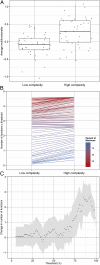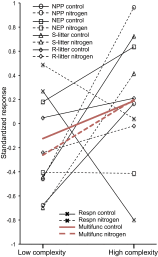Discontinuity in the responses of ecosystem processes and multifunctionality to altered soil community composition
- PMID: 25246582
- PMCID: PMC4210050
- DOI: 10.1073/pnas.1413707111
Discontinuity in the responses of ecosystem processes and multifunctionality to altered soil community composition
Abstract
Ecosystem management policies increasingly emphasize provision of multiple, as opposed to single, ecosystem services. Management for such "multifunctionality" has stimulated research into the role that biodiversity plays in providing desired rates of multiple ecosystem processes. Positive effects of biodiversity on indices of multifunctionality are consistently found, primarily because species that are redundant for one ecosystem process under a given set of environmental conditions play a distinct role under different conditions or in the provision of another ecosystem process. Here we show that the positive effects of diversity (specifically community composition) on multifunctionality indices can also arise from a statistical fallacy analogous to Simpson's paradox (where aggregating data obscures causal relationships). We manipulated soil faunal community composition in combination with nitrogen fertilization of model grassland ecosystems and repeatedly measured five ecosystem processes related to plant productivity, carbon storage, and nutrient turnover. We calculated three common multifunctionality indices based on these processes and found that the functional complexity of the soil communities had a consistent positive effect on the indices. However, only two of the five ecosystem processes also responded positively to increasing complexity, whereas the other three responded neutrally or negatively. Furthermore, none of the individual processes responded to both the complexity and the nitrogen manipulations in a manner consistent with the indices. Our data show that multifunctionality indices can obscure relationships that exist between communities and key ecosystem processes, leading us to question their use in advancing theoretical understanding--and in management decisions--about how biodiversity is related to the provision of multiple ecosystem services.
Keywords: aboveground–belowground interactions; ecosystem functioning; plant-soil feedbacks; soil biodiversity; soil fauna.
Conflict of interest statement
The authors declare no conflict of interest.
Figures


Comment in
-
Reply to Byrnes et al.: Aggregation can obscure understanding of ecosystem multifunctionality.Proc Natl Acad Sci U S A. 2014 Dec 23;111(51):E5491. doi: 10.1073/pnas.1421203112. Epub 2014 Dec 5. Proc Natl Acad Sci U S A. 2014. PMID: 25480550 Free PMC article. No abstract available.
-
Multifunctionality does not imply that all functions are positively correlated.Proc Natl Acad Sci U S A. 2014 Dec 23;111(51):E5490. doi: 10.1073/pnas.1419515112. Epub 2014 Dec 5. Proc Natl Acad Sci U S A. 2014. PMID: 25480551 Free PMC article. No abstract available.
References
-
- Cardinale BJ, et al. The functional role of producer diversity in ecosystems. Am J Bot. 2011;98(3):572–592. - PubMed
-
- Hooper DU, et al. Effects of biodiversity on ecosystem functioning: A consensus of current knowledge. Ecol Monogr. 2005;75(1):3–35.
-
- Naeem S, Duffy JE, Zavaleta E. The functions of biological diversity in an age of extinction. Science. 2012;336(6087):1401–1406. - PubMed
-
- Falkowski PG, Fenchel T, Delong EF. The microbial engines that drive Earth’s biogeochemical cycles. Science. 2008;320(5879):1034–1039. - PubMed
-
- Wall DH, et al., editors. Soil Ecology and Ecosystem Services. Oxford: Oxford Univ Press; 2012.
Publication types
MeSH terms
Substances
LinkOut - more resources
Full Text Sources
Other Literature Sources

